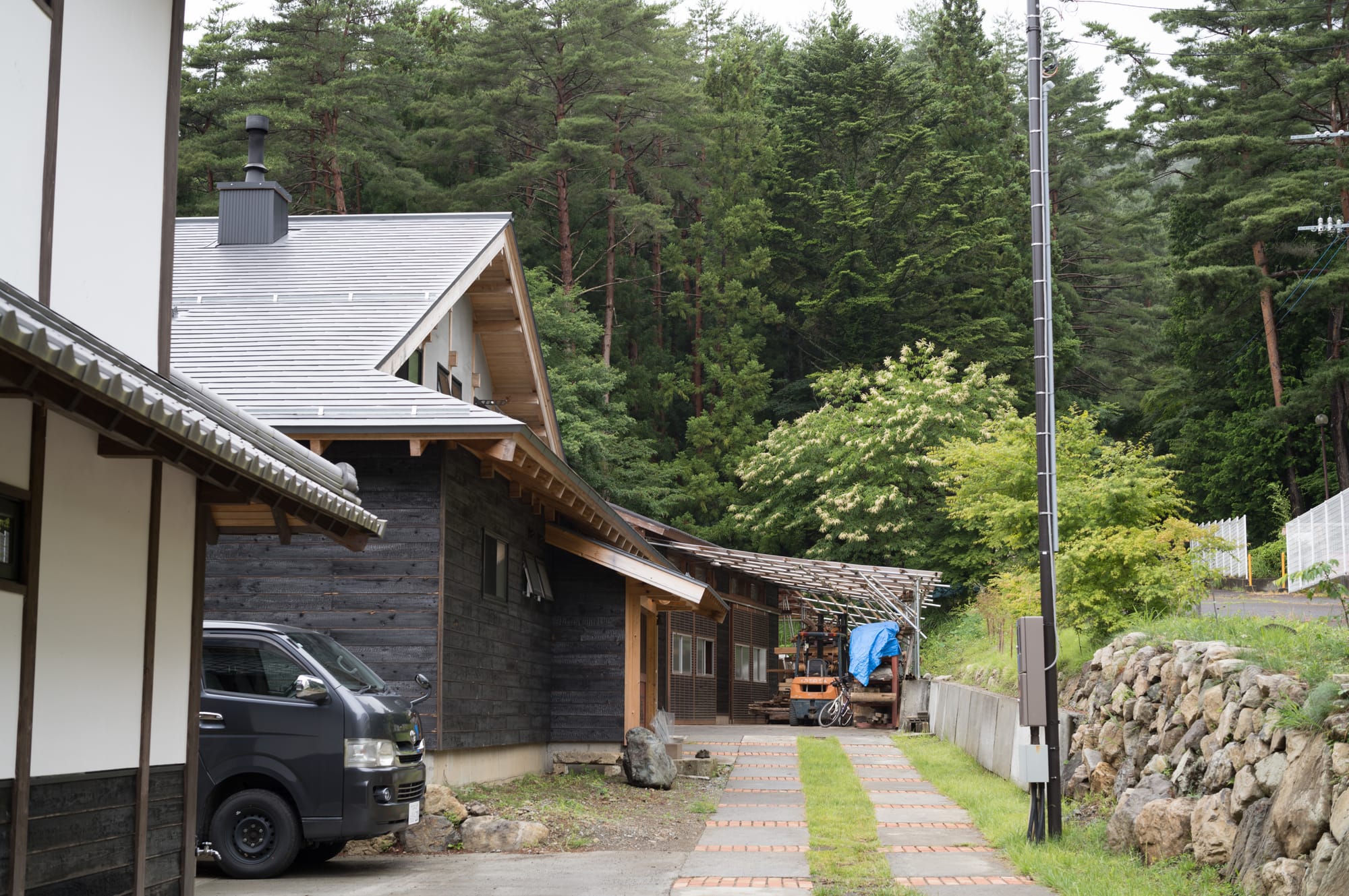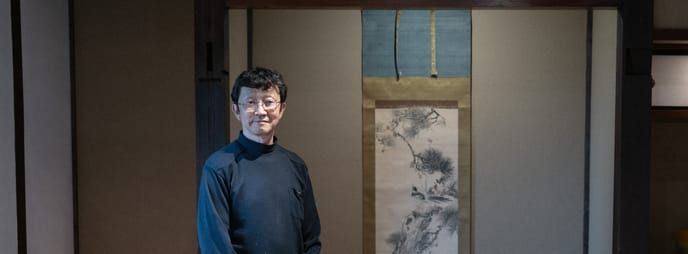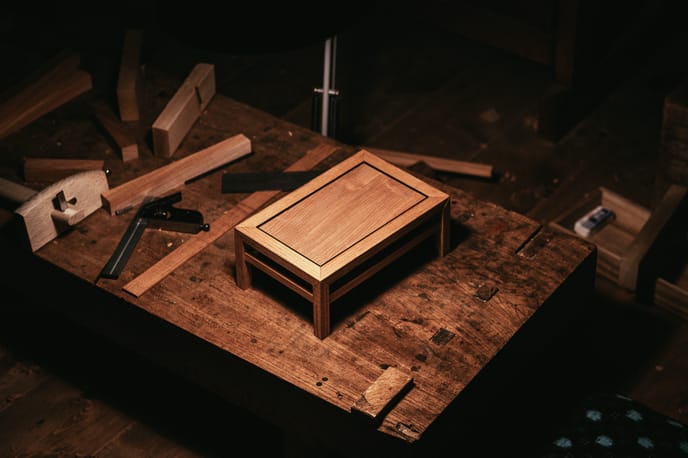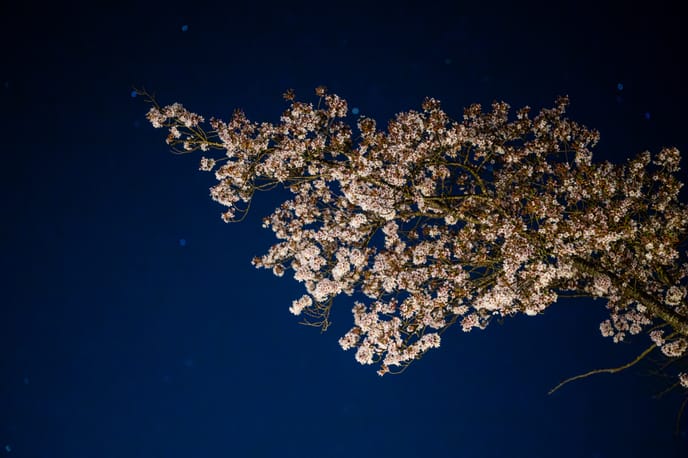To find the Mt Fuji Wood Culture Society, I went around the north side of Lake Kawaguchiko, made a right past a rice fields, and headed up a short mountain road lined with pines and a moss covered wall.

There were four buildings off the main road: Tak and Junko’s house; the chair laboratory museum; the hand tool and machine shop. Past that, there is a warehouse to dry trees felled and milled from the rest of the 3-acre property. Even though built in a traditional timber framed style, these structures only sprung up in the last 2 years as Tak Yoshino’s 20-year old dreams of a place for a woodworking community came to life.
After 5 years of preparation, I was finally able to study woodworking in Japan. I choose this school for a reason.

There are a few ways for foreigners to learn how to use Japanese woodworking tools, in a carpentry context. But there were no ways to learn from someone with Tak Yoshino’s specialties–furniture and chair making, and sashimono (intricately joined objects)—other than through professional schools and apprenticeships. That changed when Mt Fuji Wood Culture Society’s school opened last year. When he and his apprentices are not making chairs during the cooler months, the benches are occupied by international students.

I slept on the second floor, above the work spaces. My room overlooked woods with pines and chestnut and cherry trees. It was rainy season, but the occasional heat wave would allow for a sliver of Mt Fuji.

Lying down for the first time, I noticed an pegged mortise, in a beam, waiting for a tenon that it would never see.

After settling in, we all met in the woodshop. Yoshino-san, asked to be called Tak. I asked if I could call him Yoshino-san. We settled on Tak-san.

Tak-san was soft spoken. Over the weeks, we would gain a sense of his open-mindedness and through the stories he would tell about his life. He grew up studying jazz piano but switched focus to furniture at 21, after meeting another young pianist with supernatural skill. Still, all of his work and methodology seems to carry that sense of improvisation, harmony and creativity, often through a sense of flowing three dimensionality and curvature.
Today, he sought to get a sense of who his new pupils were. The students were asked to give their backgrounds, goals and show Tak any tools they had brought. As is my usual for work study trips like this, I travel heavy with a pelican of tools I set up to account best I can for any need, which is always one of the things I am a little embarrassed about. Tak noted I had some experience sharpening and setting up tools. I told him my story of craft, how much I had studied and practiced, and my goals to learn more from people who were part of a tradition.
I did not really belong in this class. The school offers day and week long classes, but these month long classes were structured as an intensive for people who are beginners with no experience and few or no tools. There’s an artists in residence program, but that involves little instruction–just working space and time. Since there are no other options to train with Tak, once in a while, people with more experience try to jump into these beginner classes, and fit in their own agenda between the official class plan. There's always room to learn a new master's style, which I enjoy contrasting with other teacher's particular methods. And fundamentals are great to go over once in awhile, no matter the experience level.
Our class had 2 beginners, one person who had taken a class before, a professional, and someone (me) who was neither a beginner nor a professional. I unpacked my giant pelican case of tools, which Tak inspected carefully. And then, were arranged by Tak on benches in order of seniority.

Alfred from Brittany (the professional) took Tak’s bench. I was assigned the next bench over. The joke in class that day was that the person with the most tools got the smallest work space. I didn’t mind that, but everyone’s bench had a planing stop built in that I missed during the month’s studies. Togo, Tak’s current apprentice, took a spot furthest back, next to Takuya, Tak’s most recent senior apprentice, who graduated and was starting his own chair making company from the corner of the bench room.
After a tour of the land, we headed to the chair lab, built from the reused frame of an old minka (farm house.) Downstairs, there are a few hundred chairs collected by a mentor that donated them to be showcased in a museum.

Upstairs exists as an event space and a showroom for Tak’s own work.

The room is filled with his chairs. There is a chair featured in Hawaii’s wood craft show.

And his Zen chair, which is perhaps his most personal and well known project. The Zen chair is a custom fit chair that was created in line with the feeling one would feel sitting zazen. And shaped with specialized tools, including his collection of nearly 300 custom hand planes.

A tatami room in the chair lab holds various cabinets, trays and a table meant for tea ceremony.

Behind a piano was a case of ornate boxes in a sashimono style of his own. He showed us a curved handled tray, which he had entered in Tokyo’s craft exhibition when he was 28. Every surface of this tray was planed, using tools with various radius.

Next Tak-san showed us a cabinet with curved cross sections. Sashimono is generally straight or with some gentle angularity. Tak’s work is free flowing and unrestricted by rectilinear geometry, made capable with his custom planes, and his jazz mind.

I mentioned this box reminded me of Suda Kenji’s work, but with curvature.
Tak showed a look of amusement and then said, “oh really? Suda Kenji was my master.”
Suda Kenji is a 5th generation Sashimono, national living treasure, perhaps the most famous sashimono known outside of Japan. My craft dream was always to study with Suda Kenji, but that would have been impossible. Traveling to Japan, and entering a beginner class, I had no idea what I would try to learn this month. But at that moment, I got a better idea of what was possible.
Since Mount Fuji Wood Culture Society has been open less than 2 years, very few people have had the chance so far to learn from Tak-san. Even fewer the number of people who visited with some experience, and who would be able to ready to understand the opportunity to learn chair making, but also, sashimono from someone like Tak, a part of Suda Kenji's professional lineage.

Subscribe





